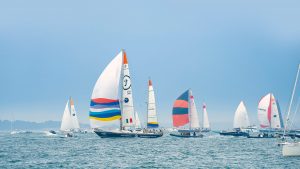Marie Tabarly, the daughter of French sailing legend Eric Tabarly, has stepped out from the shadows of her famous father and rewritten history, becoming the first over the line in…
Ocean Globe Race
Maiden’s all-female crew win the Ocean Globe Race
Maiden has beaten 14 teams to win the Ocean Globe Race on IRC handicap, becoming the first ever all-women crew to win an around-the-world yacht race, it was confirmed early…
Maiden poised to win Ocean Globe Race
The all-women crew crossed the Royal Yacht Squadron finish line shortly before midday to whoops and cheers from a large crowd gathered on the parade, then quickly hoisted the spinnaker…
Marie Tabarly rewrites history, taking line honours in the Ocean Globe Race
Marie Tabarly rewrote history last night, surpassing her famous father’s record by taking line honours in the Ocean Globe Race, and in the days ahead could potentially win the OGR…
Translated 9 retires from Ocean Globe Race, taking on water
Translated 9, one of the leading yachts in the Ocean Globe Race, has retired from the round-the-world race with hull damage and has diverted to Portugal. The Italian yacht, the…
Ocean Globe Race leader forced to return to Falklands with severe hull damage and a risk of sinking
Translated 9, the leading IRC yacht in the Ocean Globe Race has been forced to divert to the Falkland Islands after discovering two cracks on the hull, one of which…
Ocean Globe Race yachts head for the Southern Ocean
At 1400, November 5, South African Naval Vessel SAS King Sekhukhune 1 and French Navy Frigate Floréal signaled the start of Leg 2 of the Ocean Globe Race. The Cape…
The 2023-24 Ocean Globe Race
Hundreds of spectator boats cheered the start of the Ocean Globe Race on Sunday 10 September, as 14 iconic yachts raced through the line off Cowes, at the start of…
Injured yachtsman safely airlifted to hospital in Ocean Globe Race
Stéphane Raguenes, a crew member of the French racing yacht Triana (66), was airlifted by helicopter from a life raft in 2.5-metre seas approximately 225 miles from the island of…
Spectacular start to the Ocean Globe Race
A flotilla of well-wishers, including Britain’s largest working steamship, Shieldhall, waved and clapped the Ocean Globe Race fleet to the starting line opposite the Royal Yacht Squadron on the Isle…














